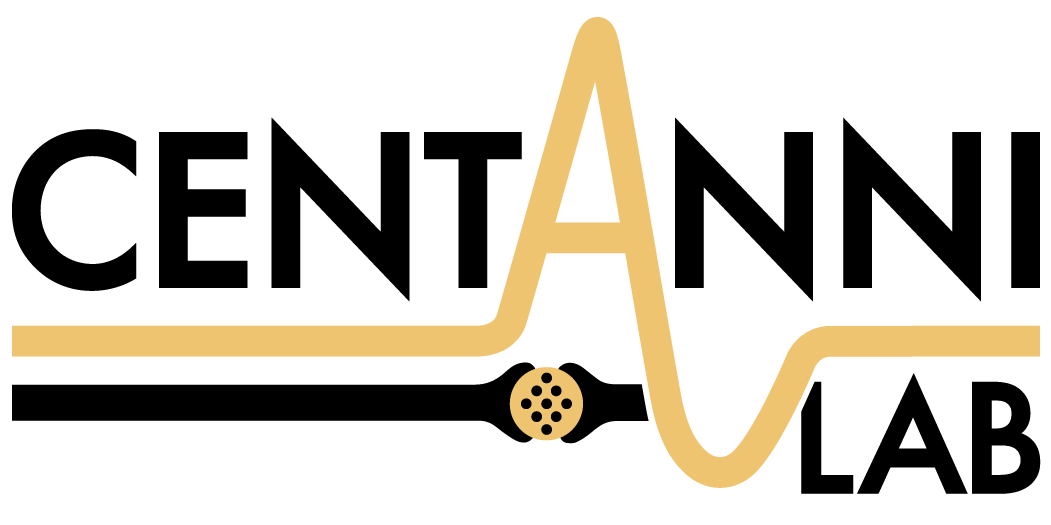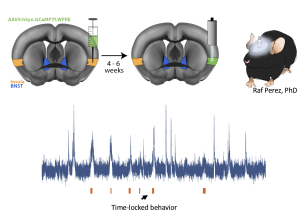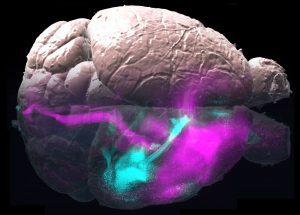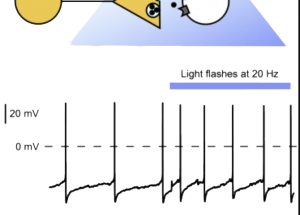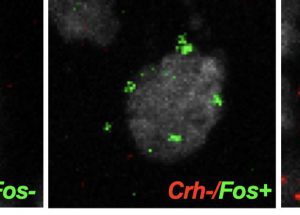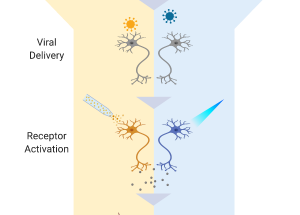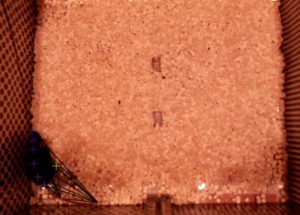in vivo Fiber Photometry
Fiber photometry is a powerful tool used for detecting and quantifying bulk fluorescence in the brains of freely moving animals. This technique can be combined with targeted viruses that express activity-dependent sensors. The Centanni lab uses fiber photometry in combination with a number of novel calcium, glutamate, GABA, and other fluorescent sensors.
Light Sheet Microscopy
Light sheet microscopy is an emerging technique that allows for imaging of whole delipidized rodent brains and other organs that can then be reconstructed to provide a single 3D image. Light sheet microscopy works by taking very small serial images by passing “sheets” of light through the tissue. This approach provides high resolution and near seamless reconstruction of specimens. The Centanni lab use light sheet microscopy in combination with endogenous virus expression and immunohistochemistry to visualize whole brain circuitry with unprecedented special resolution.
Acute Slice Electrophysiology
1. Whole cell electrophysiology is an established technique optimized for probing individual neurons and recording electrical activity. Acute brain slices are maintained using artificial cerebrospinal fluid, and a micropipette is used to gain access to the cells. Once accessed, electrical activity is measured using a digitizer and amplifier. The Centanni lab uses this technique to characterize spontaneous and evoked activity of specific cell types in specific brain regions under specific experimental conditions (e.g. after alcohol exposure or stress).
2. In addition, the lab uses a sub-technique called channelrhodopsin assisted circuit mapping (CRACM). This involves injecting a virus expressing channelrhodopsin into specific upstream brain regions to gain control of a circuit. A neuron in the target region is recorded from, and optical stimulation of the terminals expressing channelrhodopsin can help determine whether two brain regions are functionally connected.
Fluorescent in situ Hybridization and Immunohistochemistry
FISH is an immunochemical technique used to “tag” RNA expression in cells. Immunohistochemistry is a technique that uses antibodies to visualize protein expression. Both techniques are widely used in the lab. For example the immediate early gene c-fos, a proxy for neuronal activity, can be assessed in brain slices or whole brains to determine which cells are active under specific conditions (e.g. after alcohol exposure or stress)
Fluorescence Lifetime Imaging Microscopy
FLIM is an alternative strategy for measuring cellular activity both in vivo and ex vivo. FLIM uses laser excitation and picosecond fluorescence detection to determine the time it takes for an excited fluorophore to return to ground state. This allows for extremely precise measurements of activity in a reliable and consistent manner, ideal for longitudinal measurements or discrete protein activity. The Centanni lab uses this technique to measure in vivo cAMP-dependent protein kinase A (PKA) activity using a FRET-based PKA sensor (FLIM-AKAR) expressed in specific cell types. We can measure real-time PKA activity in freely moving mice undergoing various tests.
Chemogenetics and Optogenetics
Chemogenetics and optogenetics use modified receptors or ion channels to gain control of specific circuits and cell types using either pharmacology (e.g., DREADDs) or light activation (e.g., channelrhodopsin) to allow for bidirectional control of neuronal activities. This strategy is used in the lab with our stress and alcohol models, and can be combined with a number of the other techniques highlighted here.
Preclinical Models of Affective Behavior
The lab performs several mouse behavior models to assess stress and negative affect including the novelty suppressed feeding test (NSFT), open field test (OFT), light/dark test (LD), elevate plus/zero maze (EPM, EZM), Startle Response, etc. The lab has adopted machine learning based algorithms to measure discrete mouse behavior that occurs during these tasks. DeepLabCut provides highly precise, unbiased, accurate measurements that can be used to categorize behavioral phenotypes that are specific to a condition (e.g., alcohol exposure or stress).
